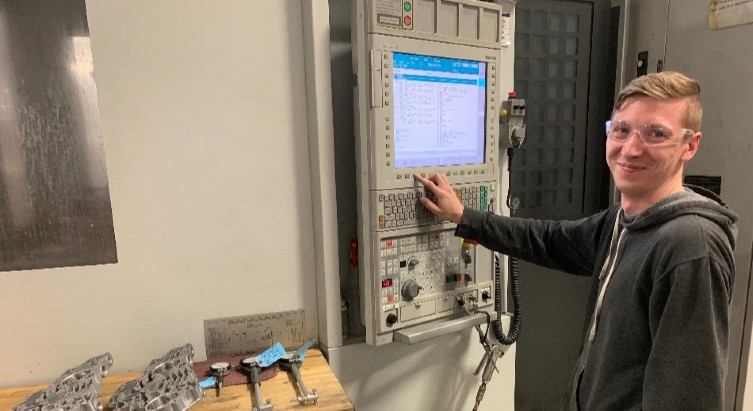The metalworking industry needs more CNC operators. This rewarding career appeals to people who have a broad skill set: a good eye for detail, math, mechanical design, and the ability to read technical drawings. CNC operators use a combination of brains and hands-on work to properly transform a metal casting into a valuable working machined part.
Before we answer “What is a CNC operator?” let’s explore what a CNC machine actually is.
A computer numerical controlled (CNC) machine uses a program to control the operation of machine tools such as lathes and mills. It takes a raw material (metal, plastic, etc.) and cuts, grinds, drills, turns, mills, and/or shapes it into parts that meet exact specifications. “Exact” is a key word for CNC operators. Fractions of a millimeter make a difference, and there’s very little room for error.
Why Does a CNC Operator Need Rhythm?
One key to a smooth, fast-paced day as an operator is to have a routine that allows you to get into a rhythm. You’ll need to focus on different tasks in your work area: changing a part, inspecting a part, observing tools, etc. Establishing a rhythm not only makes you more efficient, it also helps the day fly by because at all times you know what you should be accomplishing.
No two work days are exactly the same. Yet, here’s a look at some typical CNC operator tasks and situations.
Okay, CNC Operator, Begin Your Day!
After punching in and putting on safety gear, you report to your assigned work center. Your first 15 minutes is gathering the supplies you need for the day and talking with the previous shift operator who shares any machine or part quality issues you need to know.
This teamwork allows a CNC operator to plan tool changes and audits for maximum efficiency. Each fixture is designed differently, so you check the provided loading instructions for this part to ensure these precision machines will operate properly to meet exact specifications.
You unload your first finished part to the deburring bench, where it is blown free of coolant and any small metal pieces. You load a new, raw part onto the fixture. You double check that the part is properly loaded. The rhythm has already started.
CNC Operators are Key to Quality Control
You get back to the part on the deburring bench. Deburring, the removal of attached metal chips or shavings remaining on the part after machining, helps maintain quality because chips could cause misloads or damaged parts. Each part has specific instructions for deburring that CNC operators follow.
This first part needs to undergo an in-process audit, a check of part dimensions using a variety of measuring tools: a caliper, bore gages, pin gages, thread gages, depth gages, and both ID and OD micrometers.
An audit schedule could be every 2 or 4 hours, every hour, or even every part, depending on how critical the feature is to part quality. After the audit, the part is inspected by quality assurance on a Coordinate Measuring Machine (CMM) to verify all dimensions and positions are in tolerance, not just the critical ones covered in your audit.
The Rhythm Continues
As a CNC operator, you make sure the machine is running at capacity and meeting target rates. Throughout the day, you also monitor the tooling used on each part to ensure that it’s performing properly. A dull tool causes excessive burrs or out-of-tolerance dimensions. You watch for part quality as you deburr them, listen for odd sounds from the machine, and pay attention to the machine’s alarm that tool life has been met.
When you reach the end of your shift, you overlap for 15 minutes and keep the machine running for the next CNC operator. You share how the machine and parts ran for the shift, record production, and wash up before the bell rings.
From one day to the next, (or even one hour to the next), you could be using hoists to lift and move parts and equipment, cleaning and packaging completed parts, performing changeovers, collaborating with another team member, or meeting with customers.
A CNC Operator is Different from a CNC Machinist
You may have heard of another career in a CNC machine shop: the CNC machinist. Think of a CNC machinist as a more advanced and experienced CNC operator. CNC machinists program machinery, troubleshoot mechanical issues, and read blueprints and part drawings.
Many CNC machinists start out as CNC operators, who they now supervise and instruct. Once operators develop in-depth knowledge of machine operation, get to know the properties of metal, and experience years of on-the-job CNC machining, they may try to move up.
How Does Someone Become a CNC Operator?
One thing many people like about a CNC operator career is that experience is not required and training is mostly provided by a CNC machine shop. On-the-job training can be combined with classes in math, 3D design, blueprint reading, and specialized CNC operator training at local technical schools or community colleges.
Many CNC operators enjoy their various job responsibilities: taking on mechanical challenges, setting up equipment, controlling quality, and using hand tools and precision measuring instruments. CNC operators usually have plenty of job opportunities and earn healthy wages.
At Stecker Machine Company, we primarily machine aluminum and iron castings. Our state-of-the-art CNC equipment helps us meet our customers’ stringent quality requirements, and our plants offer safe and efficient production environments. Want to join our team as a CNC operator? See our current job openings.







